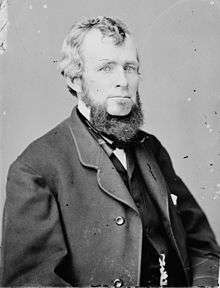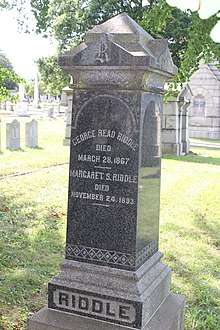George R. Riddle
George Read Riddle (1817 – March 28, 1867) was an American engineer, lawyer and politician from Wilmington, Delaware. He was a member of the Democratic Party who served as U.S. Representative and as U.S. Senator from Delaware.
George R. Riddle | |
|---|---|
 | |
| United States Senator from Delaware | |
| In office February 2, 1864 – March 28, 1867 | |
| Preceded by | James A. Bayard, Jr. |
| Succeeded by | James A. Bayard, Jr. |
| Member of the U.S. House of Representatives from Delaware's At-large district | |
| In office March 4, 1851 – March 4, 1855 | |
| Preceded by | John W. Houston |
| Succeeded by | Elisha D. Cullen |
| Personal details | |
| Born | 1817 New Castle, Delaware |
| Died | March 29, 1867 (aged 49–50) Washington, D.C. |
| Political party | Democratic |
| Residence | Wilmington, Delaware |
| Alma mater | Delaware College |
| Profession | engineer, lawyer |
Early life and family
Riddle was born in New Castle, Delaware and studied civil engineering at Delaware College, now the University of Delaware. In addition he studied law and was admitted to the Delaware Bar in 1848, beginning a practice in Wilmington, Delaware. With his engineering background, he was named as a commissioner to retrace the Mason–Dixon line in 1849, and was otherwise engaged in the construction of railroads and canals. In 1844, Riddle was hired to design the Wilmington and Brandywine Cemetery.[1] During the Civil War, Riddle served with the Home Guard of Wilmington. His wife's name was Margaret.
Political career
From 1849 to 1850, Riddle served as a Deputy Attorney General of the United States. After losing in the election of 1844, he was elected to the U.S. House in 1850 and served for two terms from March 4, 1851 until March 3, 1855. During the 33rd Congress, Riddle was the Chairman of the Committee on Engraving. Running for a third term he was defeated in 1854 by Elisha D. Cullen.
In 1860, Riddle was one of only two slaveholders in Delaware. He owned three slaves, a 68 year old male and two females aged 56 and 12.[2]
On February 2, 1864 Riddle was elected to the United States Senate to fill the vacancy caused by the resignation of U.S. Senator James A. Bayard, Jr. He served until his death on March 29, 1867.
Death and legacy

Riddle died while in office at Washington, D.C. and is buried in the Wilmington and Brandywine Cemetery at Wilmington.[3]
Almanac
Elections are held the first Tuesday after November 1. U.S. Representatives took office March 4 and have a two-year term. The General Assembly chose the U.S. Senators, who also took office March 4, but for a six-year term. In this case he was completing the existing term, the vacancy caused by the resignation of James A. Bayard, Jr.
| Public Offices | ||||||
|---|---|---|---|---|---|---|
| Office | Type | Location | Began office | Ended office | notes | |
| U.S. Representative | Legislature | Washington | March 4, 1851 | March 3, 1853 | ||
| U.S. Representative | Legislature | Washington | March 4, 1853 | March 3, 1855 | ||
| U.S. Senator | Legislature | Washington | February 2, 1864 | March 29, 1867 | ||
| United States Congressional service | ||||||
|---|---|---|---|---|---|---|
| Dates | Congress | Chamber | Majority | President | Committees | Class/District |
| 1851–1853 | 32nd | U.S. House | Democratic | Millard Fillmore | at-large | |
| 1853–1855 | 33rd | U.S. House | Democratic | Franklin Pierce | at-large | |
| 1863–1865 | 38th | U.S. Senate | Republican | Abraham Lincoln | class 1 | |
| 1865–1867 | 39th | U.S. Senate | Republican | Andrew Johnson | class 1 | |
| Election results | ||||||||||||
|---|---|---|---|---|---|---|---|---|---|---|---|---|
| Year | Office | Subject | Party | Votes | % | Opponent | Party | Votes | % | notes | ||
| 1844 | U.S. Representative | George R. Riddle | Democratic | 6,023 | 49% | John W. Houston | Whig | 6,229 | 51% | |||
| 1850 | U.S. Representative | George R. Riddle | Democratic | 6,055 | 49% | George B. Rodney | Whig | 5,926 | 48% | [4] | ||
| 1852 | U.S. Representative | George R. Riddle | Democratic | 6,692 | 50% | John W. Houston | Whig | 6,630 | 50% | |||
| 1854 | U.S. Representative | George R. Riddle | Democratic | 6,334 | 48% | Elisha D. Cullen | American | 6,820 | 52% | |||
Notes
- Scharf, John Thomas (1888). History of Delaware: 1609-1888. Philadelphia: L.J. Richards & Co. p. 845. Retrieved July 28, 2019.
- Essah, Patience (1996). A House Divided: Slavery and Emancipation in Delaware, 1638-1865. Charlottesville and London: University Press of Virginia. p. 80. ISBN 0-8139-1681-X. Retrieved August 16, 2019.
- "George Read Riddle". www.findagrave.com. Retrieved July 29, 2019.
- Independent candidate Francis D. Wait received 453 votes.
References
- Martin, Roger A. (2003). Delawareans in Congress. Middletown, DE: Roger A. Martin. ISBN 0-924117-26-5.
- Wilson, W. Emerson (1969). Forgotten Heroes of Delaware. Cambridge, MA: Deltos Publishing Company.
External links
Places with more information
- Delaware Historical Society; website; 505 North Market Street, Wilmington, Delaware 19801; (302) 655-7161
- University of Delaware; Library website; 181 South College Avenue, Newark, Delaware 19717; (302) 831-2965
| U.S. House of Representatives | ||
|---|---|---|
| Preceded by John W. Houston |
Member of the U.S. House of Representatives from Delaware's at-large congressional district March 4, 1851 – March 4, 1855 |
Succeeded by Elisha D. Cullen |
| U.S. Senate | ||
| Preceded by James A. Bayard, Jr. |
U.S. senator (Class 1) from Delaware February 2, 1864 – March 29, 1867 Served alongside: Willard Saulsbury, Sr. |
Succeeded by James A. Bayard, Jr. |

